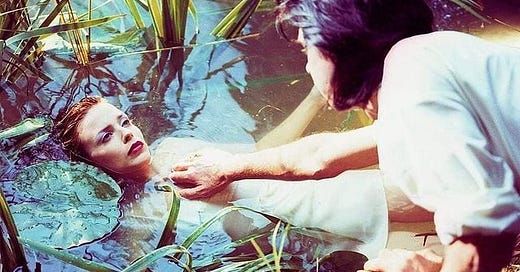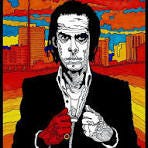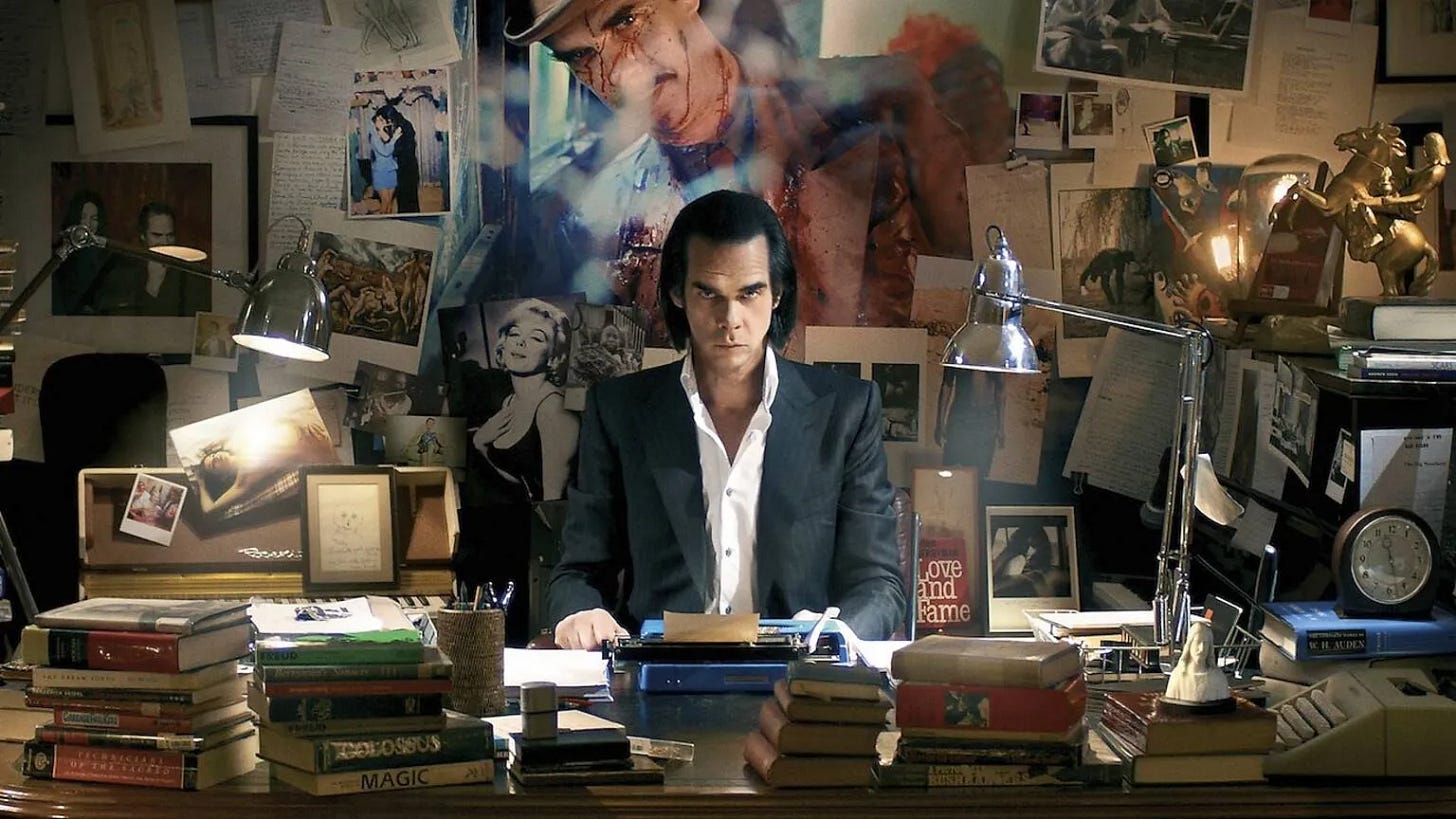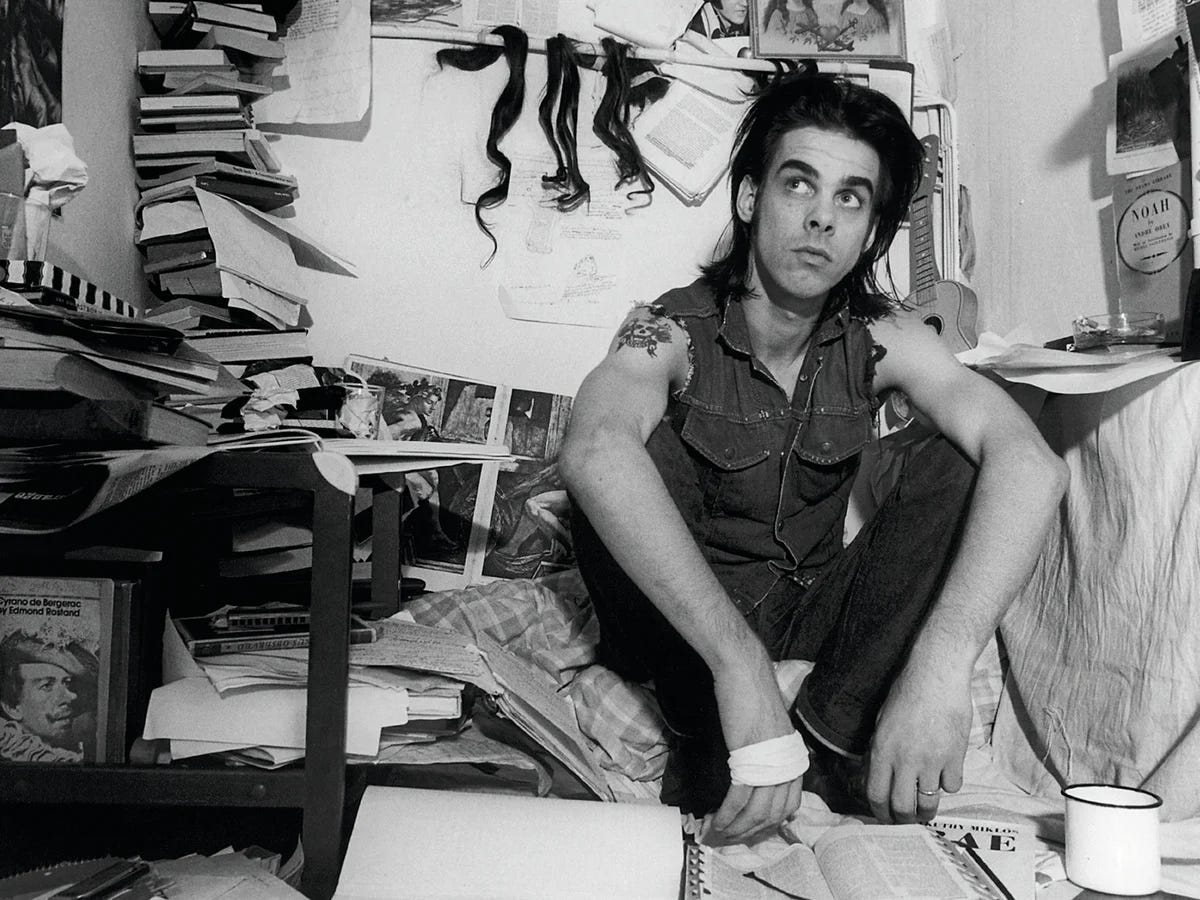“He’ll wrap you in his arms,
tell you that you’ve been a good boy
He’ll rekindle all the dreams
it took you a lifetime to destroy
He’ll reach deep into the hole,
heal your shrinking soul,
but there won’t be a single thing
that you can do
He’s a god, he’s a man,
he’s a ghost, he’s a guru
They’re whispering his name
through this disappearing land
But hidden in his coat
is a red right hand”
The above lyrics are from Nick Cave’s “Red Right Hand”, arguably his most famous song. It has a great hook, (Oh that bell ringing) and it describes one of the most oft favored subject of the hip set - the Devil.
Robert Johnson supposedly sold his soul at the crossroads to Old Scratch in return for making him the arbiter of the Blues. The Rolling Stones had some sympathy. Those horns became a hand sign at Black Sabbath shows. But the lyrics of Red Right Hand could also aptly describe the character of ‘Nick Cave’ that Nick Cave, the man, has spent six decades creating. He has been known as the “apocryphal poet preacher” and as a foreboding lyricist of the monstrous. He has recorded ballads, after all, about wild roses and murder.
Despite the beauty and lyricism of the song, a collaboration between Cave and long time Australian friend Kyle Minogue, the inspiration was an Irish story about a woman who had been murdered by a man whose love only promised destruction. It is ultimately meant to be disturbing. “For my name was Eliza Day. My Name was Eliza Day”, is the ending refrain, a voice calling out from her watery grave.
He is figure that might have made Lord Byron stand up and take notice from his crypt. Mary Shelley might have, had she been able to time travel, delighted walking with him along the moor. Or the streets of New York. Poe might have invited him over for some Eggnog.
Regardless, the - God, Guru, Ghost - aspect of the character of Nick Cave that the man behind the Cave has spent a lifetime creating is what is most prominently featured in the film 20,000 Days on Earth by Iain Forsyth and Jane Pollard.
The film is not an exploration of Nick Cave’s antics with his band the Bad Seeds, weighted with concert footage and reveling in bad boy high-jinks. It is also not a behind-the-scenes look at an icon. It is an art film. One that employs the, usually French, element of the artful voice-over to layer the almost innocuous scenes of how he spends a day — now.
“The weather is becoming a lie because I am writing about it”, says Cave while gazing cryptically out the window. And then he goes on a drive to meet and eat fresh pasta with longtime friend and collaborator, Warren Ellis.
Those devotees who are eager to delve viscerally into the myth or who hunger for an opportunity to grasp at an Idol’s soul with sticky fingers, pulling away hair and clothing pieces and possibly some vestige of that magical stuff, will be disappointed. The ‘Nick Cave’ of the film remains as elusive as he ever was. He does talk about his father’s death and his heroin days in a pseudo psychiatric session, a part of the film that is far more maudlin than Nick Cave’s music has ever been. He is also shown eating pizza and watching Scarface with his young sons. “Say heeellloo to my leetle friend”, they all intone, in unison. A charming scene.
This was intentional. As quoted in the Guardian article by Alexis Petridis, the filmmakers believed that, “The important thing for us was not breaking the mythology. The thing that seems so kind of prevalent in contemporary music docs is that they’re all about getting behind something, revealing something, taking away the mask, taking away the myth.” Forsyth and Pollard are not documentarians, they describe themselves as visual artists. They took the title of the film from a line in Cave’s songwriting notebook that marked that on the day when he began work on his latest album Push the Sky Away, he was 20,000 days old. There was no script, instead the film was constructed around improvisation or in other words, Cave enjoying riffing on life, art, songwriting, love, divinity and why he was entirely “lost”, devotion wise, to his current wife Susie Bick.
“I can control the weather with my moods, the only things is, I can’t control my moods”, is another nifty phrase in the film. This artful presentation is mostly seamless, but there is one moment in the film that reveals a deeper side. It occurs when he tells of the time when he performed on the same stage as Dr. Nina Simone, as she demanded to be called at that stage in her career. “She was unwell, a ferocious woman, full of rage”, says he. He is slightly abashed and still obviously intimidated even years after but he becomes slyly, gleeful when he tells the next part, “when one of the people handling the show tried to placate her and asked what she wanted, she replied, “I want champagne, cocaine and some sausage!””.
Archly gleeful yes, but it is apparent how much her legitimate rage - affected him.
It is the quality that made him distinctive to me when I saw him perform at the Beacon Theater in NYC in 1997. He was then, as described by Minogue, “a tree, a Hitchcockian tree, in a storm”. On that night, and in the few bits of concert footage in the film, he was resplendent in a dark suit and slicked back black hair, a lanky vision against red lights giving out wild, wicked energy and yet, a palpable sense of kindness.
At one point during that set, he danced around offering his fellow musicians neck rubs, encouragement and tender gestures. He wasn’t just some gothic gimmicky figure offering theatrical diversion. He was transportive. He was actually, astoundingly - cathartic.
He still is.
When asked if Susie or his first wife and co-songwriter Anita Lane were his ‘muses’, he replied, “No. They are people. They are themselves”. In 2018 he began The Red Hand Files as a platform to answer questions by fans. Initially. But as he says, “over the years, The Red Hand Files has burst the boundaries of its original concept to become a strange exercise in communal vulnerability and transparency. Hundreds of letters come in each week, asking an extraordinarily diverse array of questions, from the playful to the profound, the deeply personal to the flat-out nutty. I read them all and try my best to answer a question each week. The Red Hand Files has no moderator, and it is not monetized, and I am the only one who has access to the questions that sit patiently waiting to be answered. Thank you all for being a part of what has become, at least for me, a life-changing, soul enriching exercise in commonality and togetherness. Love, Nick”.
Though decadent and transgressive, Cave is never exploitive. So much so, he doesn’t even allow this incarnation of his legacy - an art film - to exploit him. In these worrisome Pop Political days, it is a quality that can earn a fellow a kind of devotional glow or perhaps, a simple but deeply respectful recognition of musical, performative and personal - integrity.
Nick Cave in West Berlin, 1985. Photograph: Bleddyn Butcher.
You can Watch the Film on Youtube or on Netflix.
~~~~~~~
From the Ginger Murray Archives: This review, since updated, was originally written for the 2014 SF International Film Festival.








